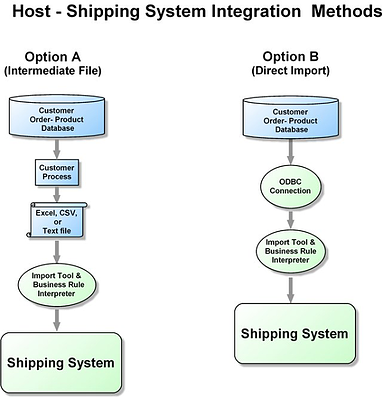One of the main purposes of shipping systems, other than printing shipping labels and maintaining records of shipments, is automating what would otherwise be an extremely laborious process of shipping packages. Automation is accomplished by integrating the shipping system with the customer's host order-entry system (or database).
Most of the information required to ship a package resides in some sort of order management system, and by integrating the two systems, the data can be made to flow seamlessly to and from the shipping system, thereby eliminating the need for manual keyboard entry. Not only is time and effort dramatically reduced, but transcription errors are avoided as well.
There are two primary methods for moving data from the order management system or database to the shipping system. First, a customer-provided process is used to export data from the host system (orders database, shopping cart, etc) to an Excel, CSV, or text file with the required information. In the second case, the shipping system is configured to connect directly to the host system's database and to import the required information automatically using ODBC, XML, tcp/ip and other "real-time" methods.

The same two methods apply to moving data from the shipping system back into the host system. The shipping system can create an export file (with tracking #s, shipping charges, etc) that gets read back into the host system in a batch. Or, the shipping system can "push" the export data back into the host system in real-time via ODBC, etc.
The primary benefits to integrating the import process:
- Reduction in manual entry errors
- More efficient shipping process (fewer keystrokes to ship a package)
- No need to maintain an additional customer address databases on the shipping system.
The primary benefits to inegrating the export process:
- Reduction in manual entry errors (keying shipping charges, etc back into host system)
- Improved customer service with real-time access to shipping status, tracking #s, etc
